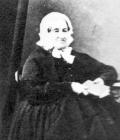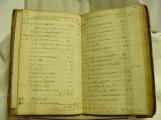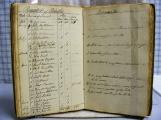

Hutchison House Museum
Peterborough, Ontario
1
Watercolour monotype of Frances Stewart19th Century, Circa 1840
Douro, Ontario
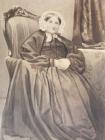 Credits:
Credits:Hutchison House Museum, Peterborough, Ontario
2
Frances Stewart and her husband were among the earliest settlers in Peterborough County. She wrote many letters to friends and family both in Ireland and Canada. Her letters, published after her death, detailed how an immigrant family adapted to the pioneer lifestyle while trying to maintain an air of gentility.Frances Stewart was born May 24, 1794, in Dublin, Ireland. She met Thomas A. Stewart in the summer of 1816 and they soon married. Thomas had a modest income, but due to hard times in Ireland decided to immigrate to Canada with his family along with his brother-in-law Robert Reid and his family. The Stewarts and their daughters sailed from Belfast to the New World on February 9, 1821.
The Stewart and Reid families stayed in Cobourg while Thomas and Robert set out to explore Douro Township at the head of the Trent River. Their cabin was built on a bank above the river. The Stewarts left Cobourg in February of 1822 to their unfinished home. In the first year Thomas built furniture for the house, cleared the land and planted crops. Until the crops came in they ate salt pork, pea soup, bread, and wild plants, and drank tea (made from hemlock tips) and coffee (derived from burnt Indian corn).
3
'Auburn' Home of Frances Stewart in Douro19th Century, Circa 1830
Douro, Ontario
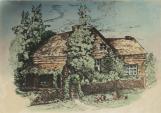 Credits:
Credits:Peterborough Museum and Archives 1978-012 (V4pg9)
4
Stewart and Reid oversaw the colonization of 10,000 acres in Douro over three years. Due to the lack of "civilization" and company in the backwoods, the Stewarts were thinking of moving to Cobourg when they heard about the Peter Robinson Immigration. With the immigration came the makings of a village in the area with shoemakers, carpenters, a mason, a baker, and plans for an Anglican Church and school.In 1826 Sir Peregrine Maitland and several guests visited the settlement. The Stewarts attended his reception at the government house. It was at this meeting that Frances suggested the name 'Peterborough' for the little village in honour of Peter Robinson.
In 1833 Thomas A. Stewart was appointed to the legislative council at York, a position he held until 1841. Stewart was active in local affairs and in many instances sat on the same committees as Dr. Hutchison such as the Peterborough General Society and the building committee for the Peterborough County Court House.
5
Frances Stewart recounting their first year in Douro19th Century, Circa 1822
Douro, Ontario
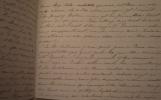 Credits:
Credits:78-008/2/14 #277
Trent University Archives, Peterborough, Ontario
6
Life in the backwoods of Canada was much harsher than back home in Europe. The area was mostly forest, neighbors were far apart, and while diseases like ague and cholera were common, there were few doctors for large areas.The first noted encounter the Stewarts had with Dr. Hutchison was in 1823 when their daughter Bessie was suffering from dysentery. Also known as flux, dysentery is an inflammatory disorder of the intestine. This results in severe diarrhea, fever and abdominal pain that can be fatal if left untreated.
Donald McIntyre, who worked for the Stewarts, traveled 18 miles from his home in Monaghan Township to fetch Dr. Hutchison. The doctor arrived 2 days later, but it was too late. Bessie had died and was buried near their cabin. Frances recounts the episode to her daughter Ellen:
"In the Autumn of our first year in Douro our youngest little girl of not quite two years old was seized with Dysentry. I was quite ignorant of the disease and there was no Doctor within reach- The nearest being Dr Hutcheson who then resided in Cavan, a good many miles distant. We had as yet no canoe on the River and were often depending on a chance visit of the Indians for a passage to the other side. One of our hired men, a faithful Highlander, seeing how very ill our darling was volunteered to swim across the rapid stream and walk through the woods to the Doctor, promising that if I wrote the particulars, he would bring the necessary medicines. He started early in the morning of a cold October day and returned about midnight with some powders, and a message that the Doctor would come up on the following day - But no improvement and the day passed in great anxiety for the Doctor did not arrive.
On the third day he came having left at the promised time, but lost his way in the woods and hence the delay. The next day she appeared more lively, but refused to take the arrowroot and says which I offered her. She asked for bread and of this we had none fit to give her, having for sometime been unable to procure good flour. It was a bitter trial not to have what she seemed to crave for."
7
Stewart entry in Dr. Hutchison's Birth Registry26 August 1830
Peterborough, Ontario
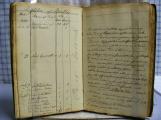 Credits:
Credits:Hutchison House Museum, Peterborough, Ontario
8
The Stewarts and Hutchisons became good friends, and the good doctor often appears in the tales and descriptions of the backwoods that Frances writes home to friends and relatives.In 1823 she describes Dr. Hutchison as:
"… There is a most skilful doctor who lives about fourteen miles off. He visits every family in the neighborhood once a fortnight, and appoints places where he can receive messages. Our names are down on his lest; every one he visits in this manner pays him three dollars a year! He is a Scotchman, young but clever."
Dr. Hutchison was close enough to the Stewarts that she felt comfortable lending him books. These were an expensive commodity to backwoods families. The collection that the Stewarts had were sent from family and friends back home in Ireland.
"The books are wonderful comfort not only to us but to many others- Mr Rubidge & Dr Hutchison have borrowed many of them-"
There was a friendly rivalry between Ellen Stewart, Frances' daughter, and Dr. Hutchison. Both planted peach stones at the same time and watched avidly to see whose would be the first and best to grow.
9
Frances Stewart letter written to Harriet Beaufort, Dublin14 December 1840
Peterborough, Ontario
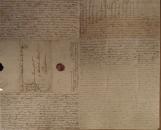 Credits:
Credits:78-008/2/10 #178
Trent University Archives, Peterborough, Ontario
10
The Stewarts were faithful subscribers to Dr. Hutchison's medical insurance and with nine children the Stewarts saw him a lot. One such episode is described by Frances in a letter to her good friend Harriet in which Edward, who was an employee and like family, was accidentally shot:To Harriet Beaufort, Dublin, Dec 14th ,1840
"…1st sleighing has begun & the roads are in tolerable order now & 2nd many friends have called to enquire about poor Edward- who lately met with an accident which alarmed us greatly & might have been very serious, but most providently has turned out not so bad- A gun went off accidently and wounded him-in his shoulder- he bled most profusely- indeed frightfully- so that he was as I thought lifeless when brought home- & for some hours we feared he never could live- but miraculously the Dr. says, no vital part was touched- tho' the space was inconceivably small between the wound & a great artery on one side & a muscle on the other which was only grazed but which would have injured the use of his arm- tho still wan & weak & suffering a good deal of pain- but we all have reason to feel thankful that the life of our poor excellent friend has been spared"
Another common event was recorded Frances in June, 1843 when her daughter Ellen, who suffered from 'Low Spirits,' or Melancholia, stays with the Hutchisons for treatment:
"Ellen will stay with Mrs H to be once more under the care of our dear, good doctor…he cured her twice before."
11
Stewart entry in Dr. Hutchison's Patient Ledger19th Century, Circa 1830
Peterborough, Ontario
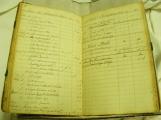 Credits:
Credits:Hutchison House Museum, Peterborough, Ontario
12
Hutchison also vaccinated the Stewart children. It is believed that only the upper class had their children vaccinated because of the cost involved. It is thought that Dr. Hutchison was vaccinating for small pox, however Frances never says exactly what it was for.Feb 1824
"…she was vaccinated on Sunday when our little Dr paid us a visit- he improves on acquaintance very much & we like him better every time we see him."
Cholera outbreaks were common in Upper Canada during the 19th century and several serious outbreaks of cholera occurred in the Peterborough area including one in the 1820s, another in the 1830s, and several in the 1840s.
Frances writes about her worry of an outbreak, but is confident in Dr. Hutchison's skills should one occur:
"As to the cholera, I have scarcely any fears about it for my friends, and if it comes here it will then be time enough and we have the blessing of an excellent physician in Dr Hutcheson He says some years ago he had several cases under his care in this district of the real Eastern cholera but it did not spread-"
14
Thomas A. Stewart encouraged the development of the Trent Canal, worked on its building committee, raised money for the Irish famine, and was a trustee for St. Johns Church , Armour School, and the grammar school. In 1837 he drilled a small company of soldiers in preparation for the rebellion. During the summer of 1847 Thomas A. Stewart was one of the volunteers at Hospital Point along with Dr. Hutchison, caring for the sick Irish immigrants. Sadly, he became one of the casualties. Today in Peterborough there is a high school named for him, in honour of all his work for the early schools in Peterborough as well as his other achievements around town.Frances Stewart became known through the publication of many of her letters that she had written to family and friends. During a trip home to Ireland in 1853, Stewart's granddaughter, Ellen Dunlop, brought home many of these letters. Ellen eventually compiled these letters into a book and publish them as 'Our Forest Home', giving us one of the earliest accounts of life in Peterborough and great insights into the trials of life in the backwoods of Upper Canada from the perspective of a middle-class Irish woman.
15
Young Catharine Parr Traill19th Century,Circa 1820
Suffolk, England
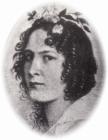 Credits:
Credits:NAC C-067337
National Archives of Canada, Ottawa, Ontario
16
Catharine Parr Strickland was born in Suffolk, England on January 9, 1802. She was the fifth of six children. Growing up, Catharine learned much about nature and plants from walks with her father, Thomas Strickland.Upon her marriage to Lieutenant Thomas Traill in 1832, the pair had already made the decision to emigrate and join her brother Samuel Strickland and his family in Upper Canada. They were joined on their adventure by her sister and brother-in-law, Susanna and John Moodie.
The Traills set sail for Upper Canada on a cargo ship named Rowley during the first week of July, 1832, and arrived in Montreal on August 21. Before they were able to set out on the rest of their journey to the backwoods, Catharine was stricken with what they believe was cholera, a disease that was ravishing the cities and new immigrants. After several days of confinement and severe pain, Catharine recovered enough to continue on towards their new home in Douro Township
17
They finally arrived in Peterborough on September 9, 1832. Catharine and Thomas stayed with her brother, Samuel, and his family in Lakefield, until their cabin could be built. The Traills quickly made friends with many of the good families of Peterborough, including the Stewarts, who helped them during their first months in the backwoods. Catharine and Frances Stewart, in particular, became great friends. Both were interested in literature and botany, and Frances shared all of the wisdom she had gathered during her first years in the backwoods. Through Frances, Catherine "learned more practical lessons for my guidance in the new life of a settler's wife in the backwoods than any book could have given me, had any book been written on the subject." Their first home was named Lake Cottage and sat on land with a grand view of Lake Katchewanooka and her brother's home.Over the years Catharine and Thomas were forced to move several times due to financial hardships. They lived in Douro, Ashburnham, Gore's Landing and Lakefield.
19
The first few years in the backwoods would be an easy time for the Traills. Thomas worked at clearing the land and planting crops; Catharine explored the area and made friends with the local natives. Catharine's early letters home were compiled for publication with hopes of encouraging future immigrants. 'The Backwoods of Canada' was published in London in two parts 1834 and has been reprinted in many editions since.21
In addition to claiming a close friendship with the Hutchisons, the Traills also subscribed to the doctor's medical insurance and were faithful subscribers until his death. Catharine later compares an instance where Dr. Hutchison diagnosed one of her children, to an illness that was affecting Ellen Dunlop's brother-in-law, Dr. Thomas Hay.To Ellen Dunlop, Decemeber25, 1856 re: Fatal illness of Ellen's brother-in-law
"…The poor Doctors sufferings from the boils I was not surprised at, for his body was in a sore state when I was with him; hardly then indeed so serious but very irritating and weakening they must have been-they often seemed to distress him- especially over the back and breast. I should consider the increase of them as a fatal symptom- When Dr Hutchison saw them on my little Helen he said she saw it wasn't far from her end- I had fancied it a good sign knowing no better- Your good husband will for many a year look back upon his labour of love, and may the consciousness of having done his duty smooth his own bed in sickness, and I trust he will not want a friend to render aid to him and his, in the hour of need, sickness, sorrow or any other adversity- Here we seem to lead a useless life, doing good to no one, not even to ourselves; our present condition seems to me like stagnant water, on which no vessel floats for either profit or pleasure-"
23
Catharine Parr Traill would give birth to nine children; the first, James George, arrived in June, 1833. When close to giving birth, Catharine would often stay with friends, such as the Stewarts, so as to be close to Dr. Hutchison in Peterborough. Dr. Hutchison would deliver five of the Traill children.Journal of Catharine Parr Traill, June 27, 1837
"…On the 16th of May just a few minutes before three o'clock it pleased Almighty God to bless my eyes with a the sight of an infant son to be named…..Owing to the badness of the roads and to the rain which fell in torrents Dr. H did not arrive till more than two hours after the birth of the babe, my only assistant was an ignorant Irish woman and our cousin Jane Allcock and I cannot but observe the contrast between females in this country & those at home under the same circumstances….."
24
The Old Doctor; A Backwoods Sketch by Catharine Parr Traill19th Century, Circa 1835-1840
Peterborough, Ontario
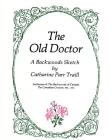 Credits:
Credits:The Old Doctor; A Backwoods Sketch by Catharine Parr Traill edited by Jean Murray Cole
Hutchison House Museum, Peterborough, Canada first edition 1985
Original illustrations by Lynne Clifford-Ward
25
The Doctor and his Patients20th Century, Circa 1985
Peterborough, Ontario
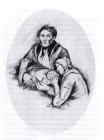 Credits:
Credits:The Old Doctor; A Backwoods Sketch by Catharine Parr Traill edited by Jean Murray Cole
Hutchison House Museum, Peterborough, Ontario, first edition 1985
Original Illustrations by Lynne Clifford-Ward
26
Throughout most of her adult life, Catharine Parr Traill kept a journal to record any notes, sketches or ideas that might be developed into stories or articles. One such sketch is an undated, fictionalized account of what is believed to be her doctor, Dr. Hutchison.This excerpt is taken from 'The Old Doctor; A Backwoods Sketch':
"The doctor was a model of strength, both mental and physical, of middle height and half as much above it but not fat; is hair silvered, but not white, still curled in thick masses above a high broad brow. The form of the head indicated metal power, firmness and decision; the height from ear to the crown showed a little too much destructiveness but the fine arch over the upper region of the forehead displayed benevolence in a still greater degree. The keen blue fiery eye, mouth slightly sarcastic, indicated to those who were skilled in reading the human mind from the human face the decisive character of the man.
The old doctor was a Radical in his way, but it was against abuses and follies, all, as he said, for the good of his species. He ran atilt at idleness and vice, knocking down all opponents with the power of his keen sarcasm and downright bluster. However, when real sympathy was required to the sick and unfortunate he was tender and generous and loving as a father. But while he shewd benevolence to such as were suffering from the visitation of God or incidental causes, he gave no comfort to the idler who was content to fold his arms and sit down in hopeless apathy lamenting over a hard fate that might have been averted by energy of body or prudent forethought."
27
Pressed Grasses from Catharine Parr Traill's Scrapbook19th Century, Circa 1850s
Peterborough, Ontario
 Credits:
Credits:96-1012
Trent University Archives
28
Catharine Parr Traill was a prolific author, writing, on average, one book a year between 1819 and her marriage in 1832. She would later go on to be recognized for her works on Canadian botany and pioneer life in Upper Canada.. Catharine wrote over 22 published works, including children's tales.Famous works include 'Letters from the wife of an emigrant officer' (1834), 'The Backwoods of Canada' (1836), 'Canadian Crusoes' (1853) ,'The Female Emigrant's Guide' (1854), 'Canadian Wildflowers' (1868), and 'Studies of Plant Life in Canada' (1885).
Catharine's writing is often used by historians today to learn about early Canadian settlers and the trials and hardships of their lives in the backwoods.
29
An Older Catharine Parr Traill19th Century, Circa 1890
Peterborough, Ontario
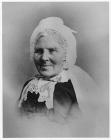 Credits:
Credits:NAC C-067325
National Archives of Canada, Ottawa, Ontario
30
Although Catharine had earnings from her writing; she and Thomas found it difficult to earn a living in the backwoods of Canada. After a fire destroyed their home near Rice Lake Thomas suffered from bouts of depression, making work difficult for him. He died in Lakefield on June 21, 1859, leaving Catharine to make her own way. A great support for Catherine at this time was Sandford Fleming, Dr. Hutchison's second cousin. He often spoke out on her behalf, trying to gain recognition for her contributions to Canada. With his encouragement the government of Canada presented Catharine with the deed to Polly Cow Island, on Lake Katchewanooka, in recognition of her important work.Catharine died at the age of 97 on August 29, 1899. She left behind a rich legacy of work in the fields of botany and backwoods guides.
31
Young Susanna Moodie19th Century, Circa 1820
Suffolk, England
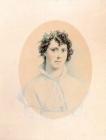 Credits:
Credits:NLC NL-15557
National Library of Canada, Ottawa, Ontario
32
Susanna Strickland, Catherine Parr Traill's sister, was born in 1803 in Suffolk, England and raised at the family home of Reydon Hall. Like her sisters, Susanna was educated by her parents in various domestic pursuits, such as gardening and dairy work, in addition to various academic subjects, such as math and history. All of the girls were encouraged to read. Five of the six sisters would go on to be professional authors, including Susanna. Her first book, a children's book, was published in 1822.In 1831 Susanna married John Dunbar Moodie (1797-1869), a retired Scottish officer who had served in the Napoleonic Wars. The Moodies would immigrate to Upper Canada with the Traills in 1832, starting their first farm in the Township of Hamilton, near Cobourg. The Moodies stayed there until 1834, at which time they moved to Lake Katchewanooka for better opportunities and to be closer to her sister.
33
Example of a Pioneer Homestead from the 'Backwoods of Canada' by Catharine Parr Traill19th Century, Circa 1836
Peterborough, Ontario
 Credits:
Credits:NLC F5458T7 1836.
Backwoods of Canada 1st edition. London: C. Knight,1836
National Library of Canada, Ottawa, Ontario
34
While living in the bush Susanna gave birth to four children and still managed to pursue her writing career. She sent many poems and stories to be published in a variety of North American newspapers including the Albion (New York), the Cobourg Star and North American (Quarterly) magazine.Unlike Catharine Parr Traill, Susanna did not have a favorable a response to life in the bush, something reflected in her collection of sketches and poems published as 'Roughing it in the Bush' (1852).
The Moodies did not stay in the bush long after John's service in the Rebellion of 1837. John Moodie was appointed the first sheriff of the new Hastings County and the family moved to Belleville in 1840.
35
Watercolour by Susanna Moodie19th Century, Circa 1872
Ontario
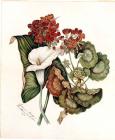 Credits:
Credits:NL15661
National Library of Canada, Ottawa, Ontario
36
Susanna Moodie to John MoodieMelsetter, Douro
Jan 11, 1839
"…How sorry you will be to learn, that I have been ill ever since you left us, confined chiefly to my bed obliged to send for Dr. Hutchinson, and even to have a nurse. During the Christmas week I was in great agony, and did little else but cry and groan until the following Sunday night, when kind Traill went himself after dark and brought up the Dr. at three o clock in the bitter cold morning. He put the lancet immediately into my breast, and I was able to turn and move my left arm for the first time for often days, for I lay like a crushed snake on my back unable to move or even to be raised forward without the most piteous cries. You may imagine what I suffered when I tell you that more than half a pint of matter must have followed the cut of the lancet, and the wound has continued to discharge ever since. I was often quite out of my sense, and only recovered to weep over the probability that I might never see my beloved husband again. Poor Jenny nursed me somewhat like a she bear, her tenderest mercies were neglect. She is however behaving better now. Dr. H. seemed greatly concerned for my situation. When he looked round the forlorn, cold, dirty room feebly lighted by the wretched lamp, he said with great emphasis, 'In the name of God! Mrs Moodie get out of this.'"
37
Undated letter by Susanna Moodie to Mrs Vickers19th Century
Ontario
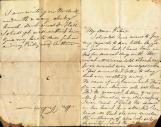 Credits:
Credits:Undated Letter, p 4, 1(69-100)
Trent University Archives, Peterborough, Ontario
38
Susanna Moodie did not always favour Dr. Hutchison. At the time the Moodies were residing near Peterborough, there were other local doctors to choose from.Susanna Moodie to John Moodie
Douro
March 6, 1839
"…Oh what a comfort this warm hearted friend was to me in my dire distress for though she could not stop my streaming tear, she helped me nurse my poor suffering children, and shared my grief. It was four o'clock in the morning before Cyprian returned faint and tired. Dr H. would not come, but said, that he would send up Dr. Dixon in the morning.
The next was a dreadfully severe day of wind, frost, and drifting snow. The dear babe was apparently worse and no Dr. came, when Cyprian, again volunteered to go down for a Dr. But Dr. H. would not be entreated. 'If you do not come, 'Cyprian said, 'the sweet babe will die.' 'I cant help that,' was the unfeeling reply. 'The roads are too bad, and I cant leave Peterboro'. 'Cyrian then went to old Dr Bird, who came up inspite of the bad roads and the dreadful night. Good old dear how kind he was- He told me that without medical aid the child must have died…"
39
Moodie entry in Dr. Hutchison's Patient Ledger19th Century, Circa 1834
Peterborough, Ontario
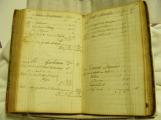 Credits:
Credits:Hutchison House Museum, Peterborough, Ontario
40
While there is no evidence that the Moodies subscribed to Dr. Hutchison's medical insurance, he did treat them on occasion as can be seen by entries in the doctor's ledger and letters written back and forth to her husband.Susana Moodie to John Moodie
Melsetter Douro
April 4, 1839
" I have suffered tortures of toothache for the last week, but Sam, who is very kind since Traills removed, has promised to bring up Dr Hutchisons instrument and extract the two which rob me of rest, by night and day."
41
Title Page from Life in the Clearings by Susanna Moodie19th Century, Circa 1853
Ontario
 Credits:
Credits:NLC-1345
Life in the Clearings. London: R. Bentley, 1853
National Library of Canada, Ottawa, Ontario
42
Susanna and John remained in Belleville until his death in 1865. Upon her husband's death, she moved around 'visiting', but mainly her daughter took her in for her last months. Throughout this time Susanna continued to write. In her life Susanna would write many children's books, novels and memoirs, as well as poetry. Her most popular work was her memoir 'Roughing it in the Bush' (1852) which even spawned a sequel, 'Life in the Clearings'. Her editor wanted her to write a useful guide for British immigrants and thus 'Roughing It' was born. Unlike her sister Catharine's 'The Backwoods of Canada', Roughing it was mostly negative, reflecting her attitude and experiences in the bush. Susanna wanted to prepare those like herself, middle-class citizens who lived in relative comfort and had no prior farming experience.43
Susanna Moodie19th Century, Circa 1860
Belleville, Ontario
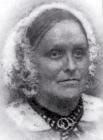 Credits:
Credits:NAC C007043
National Archives of Canada, Ottawa, Ontario
